How To Draw A Chevy Impala
The Chevrolet Impala is one of America's most-enduring automotive nameplates. In this article, you'll learn about the genesis and evolution of this iconic badge and why it outlasted so many others.
The Chevrolet Impala is one of America's most-enduring automotive nameplates. In this article, you'll learn about the genesis and evolution of this iconic badge and why it outlasted so many others.
Impala was first used for the 1958 model year to denote the Chevrolet Bel Air Impala, Chevy's new top-of-the-line model.
The original Impala gussied up the Chevrolet Bel Air with more trim and more chrome. It came as a two-door hardtop and was the only full-size Chevy model to offer a convertible body style for 1958.
Impala continued to identify the top-of-the-line big Chevy until 1966, when General Motors' best-selling brand jumped aboard the "personal luxury" bandwagon by gilding the Impala to create the even-plusher Chevrolet Caprice.
As you'll see in this article, the Impala floated around a bit within the hierarchy of Chevy nameplates. It rested comfortably just below the Caprice until 1976, when Chevrolet used the once line-topping nameplate to identify the entry-level big Chevy model.
Fittingly, however, the resurrected Impala name flourished in 1994 when Chevrolet created a Corvette-powered full-size muscle car under the Impala SS banner.
Explore the pages of this article and learn about the Impala's evolution as well as its revival. Also, check out our article on the Chevrolet Caprice to discover more about the lineup that produced the Chevrolet Impala SS.
Contents
- 1958 Chevrolet Bel Air Impala
- 1959 Chevrolet Impala
- 1960 Chevrolet Impala
- 1961 Chevrolet Impala
- 1962 Chevrolet Biscayne, Bel Air, and Impala
- 1963 Chevrolet Biscayne, Bel Air, and Impala
- 1964 Chevrolet Biscayne, Bel Air, and Impala
- 1965 Chevrolet Biscayne, Bel Air, and Impala
- 1966 Chevrolet Biscayne, Bel Air, Impala and Caprice
- 1967 Chevrolet Biscayne, Bel Air, Impala, and Caprice
- 1968 Chevrolet Biscayne, Bel Air, Imapla, and Caprice
- 1969 Chevrolet Biscayne, Bel Air, Impala, and Caprice
- 1970 Chevrolet Biscayne, Bel Air, Impala, and Caprice
- 1971 Chevrolet Biscayne, Bel Air, Impala, and Caprice
- 1972 Chevrolet Biscayne, Bel Air, Impala, and Caprice
- 1973 Chevrolet Bel Air, Impala, and Caprice
- 1974 Chevrolet Bel Air, Impala, and Caprice
- 1975 Chevrolet Bel Air, Impala, and Caprice
- 1976 Chevrolet Impala and Caprice
- 1977 Chevrolet Impala and Caprice
- 1978 Chevrolet Impala and Caprice
- 1979 Chevrolet Impala and Caprice
- 1980 Chevrolet Impala and Caprice Classic
- 1981 Chevrolet Impala and Caprice Classic
- 1982 Chevrolet Impala and Caprice Classic
- 1983 Chevrolet Impala and Caprice Classic
- 1984 Chevrolet Impala and Caprice Classic
- 1985 Chevrolet Impala and Caprice Classic
- 1994 Chevrolet Caprice and Impala SS
- 1995 Chevrolet Impala SS
- 1996 Chevrolet Impala SS
1958 Chevrolet Bel Air Impala

The 1958 Chevrolet Impala Bel Air dashboard was a riot of 1950's style and color.
The 1958 Chevrolet Bel Air Impala was the new top-of-the-line Bel Air model, lavishly equipped and soft-riding, and offered only as a Sport Coupe or convertible.
From the windshield pillar rearward, the 1958 Chevrolet Bel Air Impala differed structurally from garden-variety Chevrolets. Hardtops had a slightly shorter greenhouse and longer rear deck, giving the impression of an extended body, plus bright rocker moldings and dummy rear-fender scoops.
Simulated extractor vents on the uniquely contoured roof were inspired by Mercedes-Benz. Three taillights sat on each side, whereas lesser models had two, and wagons just one. Special crossed-flag insignias sat above the side moldings.
With a six-cylinder engine, a Chevrolet Bel Air Impala started at $2,586, while $2,693 bought a V-8. Naturally, options pushed typical total prices far higher. In all, 55,989 ragtops and 125,480 Sport Coupes were built, 15 percent of production. Stunning interiors held a competition-inspired two-spoke steering wheel and color-keyed door panels with brushed aluminum trim. No other series included a convertible.
Introduced in a blaze of publicity, Impala signaled Chevrolet's entry into the mid-price field, even if the design was less radical than planned. In addition to style and vigorous performance, ads pushed its "quick, eager-to-please handling that lets you know you're the boss." As an exclusive model, the Impala name would soon become almost synonymous with Chevy.
Longer, lower, and wider--a recurrent theme--all Chevrolets had full-coil suspension, displacing the old rear leaf springs. A new "Safety Girder" X-type frame reduced height without headroom loss. A 283-cubic-inch engine was now the standard V-8, with ratings that ranged from 185 to 290 horsepower.
Drivers who yearned to be "boss" had a new option, though: a big-block 348-cubic-inch Turbo-Thrust V-8, descended from a truck engine and tossing out 250, 280, or 315 horsepower.
The 1958 Chevrolet Bel Air Impala helped Chevrolet regained the number one production spot by a wide margin in this recession year that saw nearly all makes lose sales.
1958 Chevrolet Bel Air Impala Facts
| Model | Weight range (lbs.) | Price range (new) | Number built |
| Bel Air Impala | 3,458-3,523 | $2,586-$2,841 | 60,000 (approx.) |
1959 Chevrolet Impala
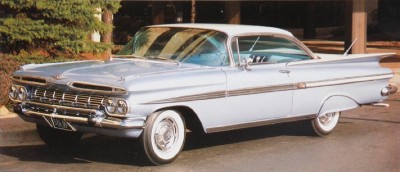
The 1959 Chevrolet Impala became a separate series, distinct from the Bel Air.
The 1959 Chevrolet Impala, following the styling excess of the late Fifties, was radically reworked and veered away from the GM pack by shooting its tailfins outward rather than upward. Admakers always were fond of naming nearly every part, but this year's "bat wing" fins above "cat's eye" taillights earned no such designations in the sales catalog. Those nicknames came later, though brochures did brand the deck "saucy."
Sharing bodyshells with lower-end Buicks and Oldsmobiles as well as with Pontiac -- part of a GM economy move -- Chevrolets rode a wheelbase 11/2 inches longer than before. Atop a new X-frame chassis, roofs sat three inches lower, and bodies measured more than two inches wider overall. Naturally, the growing size contributed to an abundance of poundage -- one more trend of the times. Always-witty auto tester Tom McCahill, of Mechanix Illustrated, declared that a Chevy's decklid had "enough room to land a Piper Cub."
Impala was now a separate series, including a four-door hardtop and four-door sedan, as well as the two-door Sport Coupe and convertible. Sport Coupes featured a shortened roofline and wrap-over back window, promising a "virtually unlimited rear view" to complement the car's new compound-curve windshield. The hardtop Sport Sedan had a huge, pillar-free back window, allowing for scads of headroom beneath its slender "flying wing" roofline.
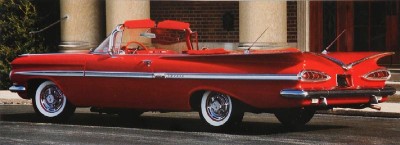
The Impala's "bat wing" styling was even more powerful on the convertible.
Base V-8 was the carryover 283, at 185 horsepower. Performance fans could select 283-cubic-inch outputs to 290 horsepower -- or turn to the big-block 348-cubic-inch V-8, in a dizzying roster of ratings, up to 315 horsepower.
With a V-8, the Impala convertible listed at $2,967, but a six-cylinder version saved the customer $118. Impala interiors flaunted their top-of-the-line status, offering such pleasantries as front and rear armrests, an electric clock, dual sliding sun visors, and crank-operated front ventipanes. A contoured instrument panel held deep-set gauges residing below hoods to prevent glare. On the comfort front, a new Flexomatic six-way power seat could be installed.
1959 Chevrolet Impala Facts
| Model | Weight range (lbs.) | Price range (new) | Number built |
| Impala | 3,570-3,670 | $2,592-$2,967 | 473,000 (approx.) |
1960 Chevrolet Impala

At $2,954, the Impala convertible was Chevrolet's most expensive 1960 car.
The 1960 Chevrolet Impala shifted direction a little, creating a more conservative look than was seen on the redesigned 1959 model.
Looking back from today's vantage point, the '59 Chevrolets don't look nearly as outrageous as they did at the time. In the eyes of today's collectors and enthusiasts, those scoffed-at tailfins are a major part of the car's appeal -- the bigger the better. Stylists and marketers back then, on the other hand, realized that the fin-and-chrome fashion had about run its course. They needed to shift direction a little, creating a more conservative face-lift.
Those sweeping horizontal fins didn't disappear, of course. Not yet. For 1960 they were simply toned down a bit, giving Chevrolets a more tasteful and temperate back end -- an angular, tapered shape that integrated neatly into the quarter panels. The effect was helped by installation of three modestly sized round taillights on each side of the top-of-the-line Impala.
Up front, those ferocious snorting-nostril air intakes above the headlights were deleted completely. By the standards of the Fifties, at least, the '60 redesign ranked as downright restrained, promoted for "Space -- Spirit -- Splendor."
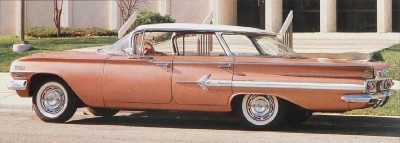
The 1960 Chevrolet Impala Sport Sedan hardtop had a panoramic rear window.
More abundantly chromed than Bel Airs or Biscaynes, Impalas found buyers more easily, with better than 490,000 built. Impalas displayed such doodads as nonfunctional air-intake scoops, plus a white band running along the rear fender. Four body styles vied for customers: hardtop Sport Sedan (with a panoramic back window within slim rear pillars), Sport Coupe, convertible, and four-door sedan. Impala hosted Chevy's only full-size convertible, leading the line at $2,847 ($2,954 with V-8).
Drivetrain choices diminished a bit, but no one could say they were deprived -- with seven V-8 engine ratings to choose from, in 283- or 348-cubic-inch size. Top choice was the 348-cubic-inch Super Turbo-Thrust Special, breathing through triple two-barrel carburetors and using 11.25:1 compression and dual exhausts to eke out 335 horsepower. More modest variants of the 348 yielded 250 to 320 horses. The carbureted Turbo-Fire 283-cubic-inch V-8 could have either 170 or 230 horsepower, but fuel injection no longer was an option under full-size Chevrolet hoods.
1960 Chevrolet Impala Facts
| Model | Weight range (lbs.) | Price range (new) | Number built |
| Impala | 3,530-3,635 | $2,590-$2,954 | 490,000 (approx.) |
1961 Chevrolet Impala

All 1961 Chevrolet Impalas had bodyside sweepspears and triple taillights.
The 1961 Chevrolet Impala was destined to become one of the most memorable Chevrolets of the 1960s by mixing full-size luxury with sport, although few realized it as the model year opened. Mid-season not only brought a Super Sport option for the Impala, but the legendary "409" engine as well -- soon to be immortalized in song by Brian Wilson and The Beach Boys.
Priced at a mere $5,380, the Super Sport was promoted as the "highly personalized version" of Impala body styles. The option group included simulated knock-off wheel covers, heavy-duty springs and shocks, metallic brake linings, padded instrument panel, a Sun 7,000-rpm tachometer on the steering column, and 8x14 narrow-band whitewall tires. The front passenger faced a grab bar, not unlike that in Corvettes, but all occupants resided on bench seats.
Super Sports could have any of three versions of the 348-cubic-inch V-8 engine, with 305 to 350 horsepower. Those ordered with a four-speed earned a special floor-mounted gearshift with a sharply bent lever. Powerglide was limited to the mildest mill. Only 453 Impalas had the SS option, most of them Sport Coupes. Just 142 of those held the big 409-cubic-inch engine. Available in no other model, the 409 breathed through a dual-snorkel air cleaner to whip up 360 horsepower and 409 pounds-feet of torque.
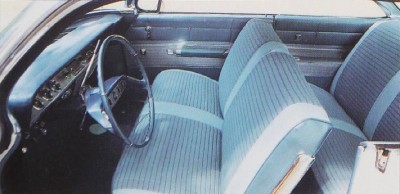
The 1961 Chevrolet Impala had color-coordinated upholstery and body colors.
The SS aimed at "customers who like sports car flair and go, teamed with big car elegance." With a 409 and 4.56:1 axle ratio, an Impala SS could hit 60 mph in seven seconds.
Three Impala rooflines were employed this year, including a Sport Coupe with gently sloping front pillars and plenty of glass. Impalas weren't devoid of gaudiness, with creased bodysides, tapered trim strips, and sculptured rear decks. They also wore deluxe wheel discs, plus wide bodyside moldings with contrasting insert panels.
Chevrolet declared Impala "unquestionably the finest car in its field." Production was almost identical to the 1960 total, at 491,000 units (including 64,600 convertibles).
1961 Chevrolet Impala Facts
| Model | Weight range (lbs.) | Price range (new) | Number built |
| Impala | 3,440-3,605 | $2,536-$2,954 | 491,000 (approx.) |
1962 Chevrolet Biscayne, Bel Air, and Impala
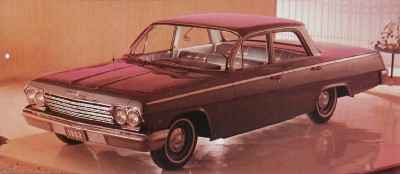
The 1962 Chevrolet Bel Air remained the mid-level full-size Chevy.
The 1962 Chevrolet Biscayne, Bel Air and Impala full-size cars got a cleaned-up, squared-off restyling, were a bit bulkier than before, and featured a trailing body creaseline. Ads positioned full-size Chevrolets at airports, under the theme "Jet-smooth Chevrolet," lauding their "room, zoom and a road softening ride" as well as the smooth new shape.
Continuing their role as the posh Chevrolets, Impalas wore full-length upper bodyside moldings (with contrasting-color inserts), ribbed body sill moldings, stainless steel window reveal trim, and special rear-fender script. Each Impala model had its own distinctive roofline, including the slim-pillar four-door sedan. Sport coupes got convertible-like rear roof creases, while new inner fenders protected against rust.
Impala output totaled a whopping 704,900 cars, versus 365,000 slim-pillar Bel Air sedans and 160,000 Biscaynes, the latter minimally trimmed but promoted for its "beautiful simplicity."
This year, the big 409-cubic-inch V-8 could be installed in any full-size model, not just the Super Sport, developing either 380 or 409 horsepower. The 409-horsepower edition breathed through twin four-barrel carburetors, while its less-potent mate made do with a single carb. Both had solid lifters and dual exhausts, with 11.0:1 compression. All-out enthusiasts could even order lightweight aluminum front body panels.
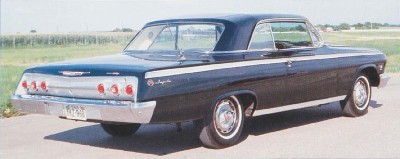
The 1962 Chevrolet Impala offered a Super Sport Trim Package.
The 348-cubic-inch engine was gone, replaced by a 327-cubic-inch option that delivered 250 or 300 horses. The 283-cubic-inch V-8 came in only one guise, at 170 horsepower, as the standard V-8 powerplant.
The Super Sport option was now a $156 trim package for the Impala Sport Coupe or convertible, available with any engine -- even the Hi-Thrift six-cylinder. That extra outlay bought front bucket seats of "leather-soft" vinyl with aluminum edging, a passenger assist bar, a console with locking compartment, aluminum molding inserts, and knock-off-style wheel covers. Hard drivers could add sintered-metallic brake linings, heavy-duty springs/shocks, 8x14 tires, and a tachometer.
1962 Chevrolet Biscayne, Bel Air, and Impala Facts
| Model | Weight range (lbs.) | Price range (new) | Number built |
| Biscayne | 3,400-3,845 | $2,324-$2,832 | 160,000 (approx.) |
| Bel Air | 3,405-3,895 | $2,456-$3,029 | 365,000 (approx.) |
| Impala | 3,450-3,925 | $2,662-$3,171 | 704,900 (approx.) |
1963 Chevrolet Biscayne, Bel Air, and Impala
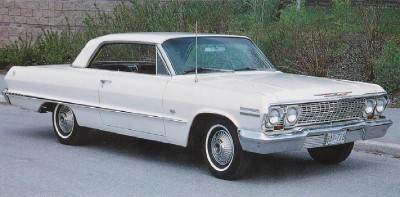
The 1963 Chevrolet Impala Sport Coupe had crisp and angular styling.
The 1963 Chevrolet Biscayne, Bel Air, and Impala enjoyed a boxy face-lift, with bodyside contours cleverly altered to look like major changes had taken place. "Clean-cut as a jewel," the sales brochure claimed, "smooth-riding as a jet." Ads touted such mundane features as "air-washed rocker panels," self-adjusting brakes, and a longer-life exhaust system.
The standard Turbo-Fire 283-cubic-inch V-8 got a boost to 195 horsepower, the mid-range 327-cubic-inch engine yielded 250 to 340 horsepower, and the big-block 409 cranked out 340, 400, or 425 horses. The latter used twin four-barrel carburetors and 11:1 compression.
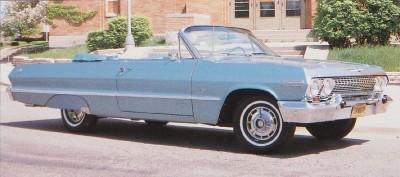
The Impala SS convertible was the most expensive full-size Chevrolet in 1963.
Quite a few buyers skipped the V-8, making do with the 140-horse Turbo-Thrift six. On the opposite end of the performance spectrum, a few lucky drag racers were able to obtain one of a handful of cars that were fitted with lightweight aluminum front body panels and held a 427-cubic-inch enlargement of the 409 engine.
Impalas again sold best, with 832,600 built (including 153,271 Super Sports). Sport Sedans had their own hardtop roofline, and Sport Coupes could now get a vinyl top. Most costly model was the aggressive-looking SS Impala convertible. Available with any engine, an SS package added $161 to the ragtop's $3,024 base price and included heavy-duty springs, aluminum-trimmed bucket seats, and swirl dashboard inserts. All SS Impalas had floor shifters, and a new console included a locking compartment.
1963 Chevrolet Biscayne, Bel Air, and Impala Facts
| Model | Weight range (lbs.) | Price range (new) | Number built |
| Biscayne | 3,205-3,810 | $2,322-$2,830 | 186,500 (approx.) |
| Bel Air | 3,215-3,810 | $2,454-$3,028 | 354,100 (approx.) |
| Impala | 3,310-3,870 | $2,661-$3,170 | 832,600 (approx.) |
1964 Chevrolet Biscayne, Bel Air, and Impala
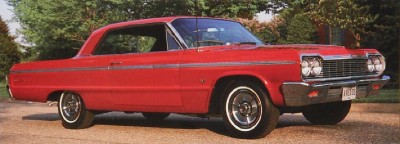
The 1964 Chevrolet Impala SS came only as a two-door hardtop or convertible.
The 1964 Chevrolet Impala added a model to the line as the Super Sport became a distinct series in '64, in either convertible or hardtop coupe form. Super Sports held a pleated vinyl interior with front bucket seats, and a console with floor gearshift (when equipped with a four-speed or Powerglide). Swirl-pattern silver anodized material decorated the rear cove outline moldings and wider upper body trim strips of SS models.
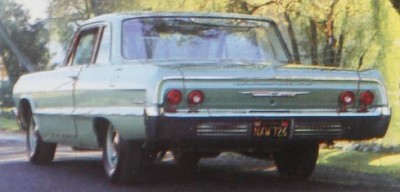
The 1964 Chevrolet Biscayne looked mundane but had a 425-horsepower engine.
Super Sports might have either a six-cylinder or V-8 engine -- though few of the former were sold. A tachometer and sports steering wheel could be added to the package. Quick-ratio power steering was available, along with a seven-position Comfortilt column.
Updated styling featured squarer corners along with a new full-width sculptured grille. Impalas again had triple taillights on each side, plus plenty of brightwork. As usual, they were the top sellers by far, with 889,600 built (including an impressive 185,523 Super Sports).
Picking a powertrain wasn't easy -- not with seven engines and four transmissions to choose from. Engine offerings ranged from a 140-horsepower six through V-8s of 283, 327, and 409 cubic inches, the last described as "especially saucy in highway passing situations." V-8s whipped up from 195 to 425 horsepower, and top engines could get Delcotronic all-transistor ignition.
1964 Chevrolet Biscayne, Bel Air, and Impala Facts
| Model | Weight range (lbs.) | Price range (new) | Number built |
| Biscayne | 3,230-3,820 | $2,363-$2,871 | 173,900 (approx.) |
| Bel Air | 3,235-3,865 | $2,465-$3,039 | 318,100 (approx.) |
| Impala | 3,340-3,895 | $2,671-$3,181 | 704,300 (approx.) |
| Impala SS | 3,325-3,555 | $2,839-$3,196 | 185,325 |
1965 Chevrolet Biscayne, Bel Air, and Impala
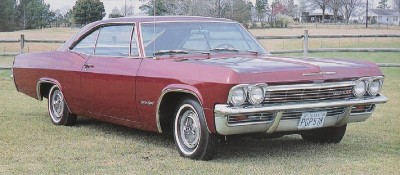
The 1965 Chevrolet Impala SS and other full-size cars got rounded bodysides, a higher beltline, and an aggressive rear-quarter bulge that year.
The 1965 Chevrolet Biscayne, Bel Air, and Impala, big-bodied cars in any year, managed to grow bigger yet. For 1965 the full-size Chevys featured dramatically rounded sides, curved window glass, and an all-new front end with fresh hood contours. A new Girder-Guard frame reduced the size of the driveline tunnel inside.
Chevrolet also promoted the cars' Wide-Stance design, adhesively bonded windshield, and improved full-coil suspension. Sport Coupes wore a sleek semi-fastback roofline, and wheel well moldings were revised. A two-tone instrument panel put gauges in a recessed area ahead of the driver.
Turbo Hydra-Matic was offered for the first time, the column-shift three-speed could have full synchronization, and a new 250-cubic-inch six-cylinder engine satisfied a fair number of buyers. A 396-cubic-inch Turbo-Jet V-8 became available midway through the model year, packing 325 or 425 horsepower -- the latter with 11:1 compression and solid lifters. The legendary dual-carb 409 was dropped, leaving only 340- and 400-horsepower renditions.
Super Sports differed slightly from regular Impalas, retaining bright windshield moldings but not the rocker panel or lower fender trim. A total of 243,114 Impala SS coupes and convertibles were built. Their new center console housed a rally-type electric clock, and full instrumentation now included a vacuum gauge.
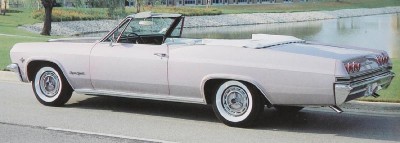
This 1965 Chevrolet Impala SS convertible is shown in the color Evening Orchid.
For $200, an Impala Sport Sedan could be transformed into a Caprice Custom Sedan, establishing a name destined for decades of life. The Caprice option group included a black-out grille, vinyl top with fleur de lis emblems, unique wheel covers, and narrow sill moldings.
They also got suspension changes and a stiffer frame -- plus the most luxurious interior ever seen in a Chevrolet, and an array of comfort/convenience features. Specially stitched cloth door panels were accented with simulated walnut, and contour-padded seats wore a combination of fabric and vinyl. All of this aimed to give Chevy buyers a "one-of-a-kind" taste of Cadillac's look and ride. Its sales success prompted Chevrolet to make the V-8-only Caprice a full series for '66.
1965 Chevrolet Biscayne, Bel Air, and Impala Facts
| Model | Weight range (lbs.) | Price range (new) | Number built |
| Biscayne | 3,305-3,900 | $2,363-$2,871 | 145,300 (approx.) |
| Bel Air | 3,310-3,950 | $2,465-$3,039 | 271,400 (approx.) |
| Impala | 3,385-4,005 | $2,672-$3,181 | 803,400 (approx.) |
| Impala SS | 3,435-3,655 | $2,839-$3,212 | 243,114 |
1966 Chevrolet Biscayne, Bel Air, Impala and Caprice

In 1966, the Chevrolet Impala SS V-8 convertible was the best-selling SS model.
The 1966 Chevrolet Biscayne, Bel Air, Impala, and Caprice were marked by blockier body lines as well as new fenders, bumpers, grille and rectangular wraparound taillights.
A 427-cubic-inch V-8 debuted -- an enlargement of the 396-cubic-inch Mark IV engine -- developing 390 or 425 horsepower. Also available: a 396-cubic-inch V-8 rated at 325 horses, and a 327. Hardtop models got new perimeter frames and body mounts as Chevrolet promised a "Jet-smoother ride." Each series -- Biscayne, Bel Air, Impala, and Caprice -- included a station wagon. Three-speed column gearshifts were fully synchronized in all forward gears.
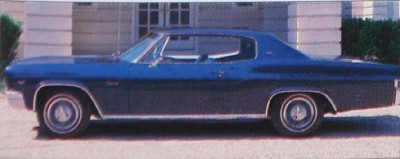
The 1966 Chevrolet Caprice Custom Coupe had its own distinct roofline.
"Bucketed, bountiful and bent on sport," the Super Sports had new slim-profile Strato-bucket seats. Impala remained the family favorite, but the posher Caprice became a separate series as a result of the nameplate's 1965 success -- when marketed as an option. Aiming at Ford's upscale LTD and billed as the "most luxurious Chevrolet yet," the four-model Caprice series was strictly V-8-powered.
Caprices could have optional reclining Strato-back front seating. The Caprice Custom Coupe got a more formal, "one-of-a-kind" roofline with decorative exhaust ports under the rear window. Like its four-door counterpart, the coupe featured wide rocker sill moldings, dual color-keyed striping, and fleur de lis emblems on roof quarters.
1966 Chevrolet Biscayne, Bel Air, Impala, and Caprice Facts
| Model | Weight range (lbs.) | Price range (new) | Number built |
| Biscayne | 3,310-3,895 | $2,379-$2,877 | 122,400 (approx.) |
| Bel Air | 3,315-3,940 | $2,479-$3,053 | 236,600 (approx.) |
| Impala | 3,430-4,005 | $2,678-$3,189 | 654,900 (approx.) |
| Impala SS | 3,460-3,630 | $2,842-$3,199 | 119,314 |
| Caprice | 3,600-4,020 | $3,000-$3,347 | 181,000 |
1967 Chevrolet Biscayne, Bel Air, Impala, and Caprice
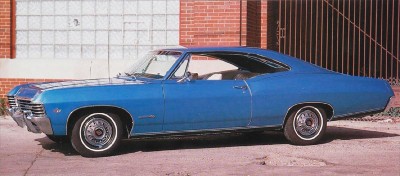
1967 Chevrolet Impala SS models sported black trim in place of chrome.
A top-of-the-line 1967 Chevrolet Caprice Custom Coupe just happened to be the 100-millionth GM vehicle built in America. Perhaps it wasn't planned that way, but could this feat have been a premonition of the subsequent popularity of Chevy's poshest model? Maybe so.
Made at the Janesville, Wisconsin, facility on April 21, 1967, the milestone luxury coupe naturally featured the Caprice's exclusive formal roofline. Often sold with an optional vinyl top, that silhouette was shared with no other Chevrolet model.
Freshly rebodied, the '67 full-sized cars looked only slightly different from their predecessors. Dimensions remained roughly the same, too, still on a 119-inch wheelbase -- four inches longer than the mid-size Chevelle. Chevrolet promoted the "lattice-work grille playing peekaboo around the front fenders."
Less decorated than other Impalas, Super Sports had black grille accents and black-accented bodyside and rear fender moldings. Lesser models leaned more toward brightwork inside and out. Both SS models -- Sport Coupe and convertible -- lacked bright wheel well trim.
Buyers could choose either vinyl bucket seats with a center console, or a Strato-back bench with a fold-down center armrest. Impala Sport Coupes (and their SS cousins) had a special graceful roofline, which flowed in an unbroken line into the rear deck.
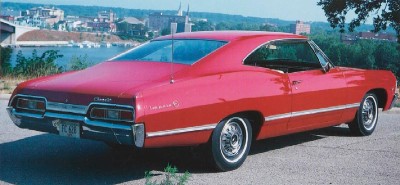
The 1967 Chevrolet Impala featured a roofline that sloped into the decklid.
Top engine this season was a 385-horsepower 427-cubic-inch V-8. Of the 76,055 Impala SS models built, just 2,124 were SS 427 editions. Only about 400 Super Sports had a six-cylinder engine.
Unlike Biscayne or Bel Air, Impalas came in a full complement of body styles, and accounted -- as usual -- for the lion's share of sales. Impala output, in fact, totaled 556,800 cars with V-8 power and 18,800 carrying six-cylinder engines, plus the Super Sports. Biscaynes continued to attract budget-minded customers, Bel Airs offered a little additional luxury, and more than 124,000 shoppers paid the extra bucks to bring a Caprice into the driveway.
1967 Chevrolet Biscayne, Bel Air, Impala, and Caprice Facts
| Model | Weight range (lbs.) | Price range (new) | Number built |
| Biscayne | 3,335-3,885 | $2,442-$2,923 | 92,800 (approx.) |
| Bel Air | 3,340-3,940 | $2,542-$3,098 | 179,700 (approx.) |
| Impala | 3,455-3,990 | $2,740-$3,234 | 575,600 (approx.) |
| Impala SS | 3,500-3,650 | $2,898-$3,254 | 74,000 (approx.) |
| Caprice | 3,605-3,990 | $3,078-$3,413 | 124,500 (approx.) |
1968 Chevrolet Biscayne, Bel Air, Imapla, and Caprice

The 1968 Chevrolet Caprice sold well, spurred by the model's claims of luxury.
The 1968 Chevrolet Caprice had a "classic" new roofline, declared this year's sales brochure. "Nothing on the road is more distinctively stylish." Once again, Caprices held such luxuries as courtesy and ashtray lights, an electric clock, and a front center armrest -- plus fancier seats and door panels. Caprice carpeting even ran up the side of kick panels and door bottoms.
Promoted as "The Grand Chevrolet," Caprices were heavily advertised and would eventually replace the Impala as an icon in the American psyche. "It can make you feel richer," the brochure continued. "At a Chevrolet price."
New windows lacked ventipanes but promised greater visibility. Astro Ventilation was supposed to pull in outside air without having to crack open a window. Most Chevrolets got hidden wipers. Retractable headlights cost $79, but few were sold, despite the clean front-end look they helped create. The formal Custom Coupe, previously a Caprice exclusive, became available as an Impala.
Standard front ends had a new face, while rear bumpers held triple "horseshoe" shaped taillights. Plush new interiors also helped attract buyers. Biscayne again served as the lowest-priced full-size model -- and looked the part. Bel Airs continued to lure middle-of-the-roaders, but Impala overwhelmed the sales charts, as it had for years.

The 1968 Chevrolet Impala had redesigned front and rear bumpers.
The posh Caprice was coming on strong, though, with 115,500 produced this season. Just as Caprice sales escalated, those of the Impala Super Sport suffered a decline. No longer a separate series, the Super Sport was a mere $179 option package for the two Impala coupes and the convertible. Only 38,210 Impalas were so-equipped, including 1,778 with the 427-cubic-inch V-8 engine (dubbed SS 427).
Full-sized cars could have a modest 250-cubic-inch six, a 307-cubic-inch V-8, either of a pair of 327s, or a 325-horsepower 396-cubic-inch V-8. Topping the list was the big 427, rated at 385 or 425 horsepower -- plenty of vigor, even in a heavy Chevy. Decisions, decisions.
1968 Chevrolet Biscayne, Bel Air, Impala, and Caprice Facts
| Model | Weight range (lbs.) | Price range (new) | Number built |
| Biscayne | 3,400-3,900 | $2,581-$3,062 | 82,100 (approx.) |
| Bel Air | 3,405-3,955 | $2,681-$3,238 | 152,200 (approx.) |
| Impala | 3,250-3,940 | $2,846-$3,358 | 710,900 (approx.) |
| Caprice | 3,660-4,005 | $3,219-$3,570 | 115,500 (approx.) |
1969 Chevrolet Biscayne, Bel Air, Impala, and Caprice
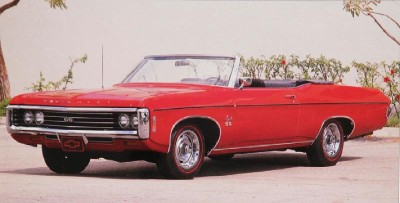
Styling changes to the 1969 Chevrolet Impala and other full-size Chevys gave the line a bigger, more imposing look.
The 1969 Chevrolet Impala and other full-size cars were redesigned to give them a sculptured look on their bodysides and a slightly longer appearance overall, but kinship to prior models was obvious. Wheelbases remained at 119 inches -- just three inches longer than four-door Chevelles.
Reshaped fenders bulged around each wheel well. Rectangular taillights went within a thinner rear bumper. A freshened grille flanked by four deep-mounted headlights were framed by a thin bumper.
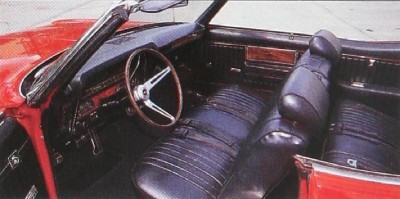
The 1969 Chevrolet Impala was the only full-size Chevy with a convertible option.
"We're out to put everybody on Easy Street," the sales brochure insisted. Impalas had Hide-A-Way wipers and vinyl-insert bodyside moldings. Biscaynes and Bel Airs again rounded out the full-size lineup, which also included the posh Caprice. Impala and Caprice coupes had a new option: an electric rear-window defogger. Ignition switches were mounted on the steering columns.
Base engine remained a 155-horsepower, 250-cubic-inch six, but the bottom-end V-8 grew to 327 cubic inches and 235 horsepower. Once again the Super Sport was an engine/trim package that cost $422. A total of only 2,455 were ordered on the Impala Custom Coupe, Sport Coupe, and convertible. A 390-horsepower, 427-cubic-inch engine gave each Super Sport model an SS 427 designation.
In-between options included 255- and 300-horsepower versions of the 350-cubic-inch V-8, as well as a 265-horsepower 396.
1969 Chevrolet Biscayne, Bel Air, Impala, and Caprice Facts
| Model | Weight range (lbs.) | Price range (new) | Number built |
| Biscayne | 3,530-4,170 | $2,645-$3,169 | 68,700 (approx.) |
| Bel Air | 3,540-4,230 | $2,745-$3,345 | 156,700 (approx.) |
| Impala | 3,640-4,285 | $2,911-$3,465 | 777,000 (approx.) |
| Caprice | 3,815-4,300 | $3,294-$3,678 | 166,900 (approx.) |
1970 Chevrolet Biscayne, Bel Air, Impala, and Caprice
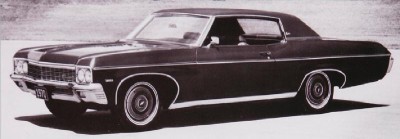
The 1970 Chevrolet Caprice remained the highest expression of Chevrolet luxury.
The 1970 Chevrolet Impala and other full-size Chevrolets lost their combined grille/bumper. In fact, front and rear ends were fully restyled, giving the impression of considerable change -- essentially an illusion, because changes were actually quite modest.
Six-cylinder engines came only in the four-door sedan, no longer being offered in two-door Impalas. Other full-size cars started with a 250-horsepower 350-cubic-inch V-8. Options included a 300-horsepower upgrade of the 350, a 265-horsepower 400, and a pair of 454-cubic-inch V-8s. Replacing the 427 V-8 and developed in part to meet forthcoming emissions standards, the new 454-cubic-inch engines produced 345 or 390 horsepower.

Chevrolet redesigned the front and rear ends of 1970 full-size Chevys.
Biscaynes and Bel Airs came only in four-door sedan form, accompanied by equivalent Brookwood and Townsman station wagons. All two-doors were hardtop-styled in the Impala and Caprice lines. Impala was one of three remaining Chevy convertibles, and only 9,562 were built. Clearly, interest in ragtops -- whether full-size or any size -- was beginning to dwindle. So was the fascination with large sporty cars, prompting abandonment of the Impala Super Sport.
Output of full-sized cars dropped sharply, below the million mark, partly as a result of a 65-day strike in the fall of 1970. Impala sales, as expected, ranked far above other big Chevrolets.
1970 Chevrolet Biscayne, Bel Air, Impala, and Caprice Facts
| Model | Weight range (lbs.) | Price range (new) | Number built |
| Biscayne | 3,600-3,759 | $2,787-$2,898 | 35,400 (approx.) |
| Bel Air | 3,604-3,763 | $2,887-$2,996 | 75,800 (approx.) |
| Impala | 3,641-3,871 | $3,021-$3,377 | 505,471 (approx.) |
| Caprice | 3,821-3,905 | $3,474-$3,527 | 92,000 (approx.) |
| Station Wagon | 4,204-4,361 | $3,294-$3,886 | not available |
1971 Chevrolet Biscayne, Bel Air, Impala, and Caprice
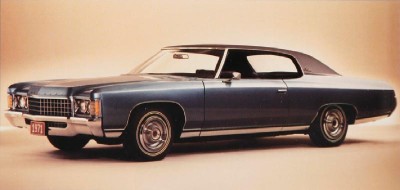
The 1971 Chevrolet Caprice resembled the Cadillac model of the same year.
The 1971 Chevrolet Impala, with its four body styles, was part of a long list of full-size Chevys for anyone who lacked the bucks to buy a posh Caprice hardtop coupe or sedan. In addition to two- and four-door pillarless hardtops, the Impala came as a regular four-door sedan and also as a convertible -- a body style that soon would begin to disappear. An Impala Custom Coupe blended the up-level Caprice roofline with mid-range trim.
Biscayne again served as the lowest-priced model and Bel Air the mid-range choice, both marketed only as four-door sedans. Standard engines were the 250-cubic-inch six and 307-cubic-inch V-8, but options ranged all the way to a 425-horsepower 454.
In addition to stretching the wheelbase to 121.5 inches (125 inches for wagons), this year's redesign changed the shape of large Chevrolets. Their bodies bulged in nearly every direction -- at the beltline, along body sides, even at the hood. A new eggcrate-patterned grille led the way, and prominent front-fender leading edges helped give Chevrolets a hint of Cadillac's look.
Impala production topped 475,000 cars (not counting wagons), but only a handful had a six-cylinder engine. Chevrolet promoted flow-through ventilation, but the vent louvers -- stamped into decklids and wagon tailgates -- soon drew complaints about water leakage.
Although the Biscayne -- available in sedan form only -- was the entry-level full-size Chevrolet, its "economy" roots were not particularly evident at a glance. Dressed up with chrome window trim, side moldings, whitewall tires, and full wheel covers, a Biscayne looked considerably nicer than its official base-model status might suggest. Despite this, shoppers willing to pay more to move up to a Bel Air or Impala were indifferent to the '71 Biscayne line; only about 22,000 went out the door. The line would disappear after the '72 model year.

Rear decks on 1971 full-size Chevys were wider and more sculpted than before.
Although the big Chevys maintained an enthusiastic audience, production was badly hurt by a 1971 UAW strike that affected all Chevrolet plants and lasted two months. Still, a total of nearly 668,000 big Chevys was nothing to sneeze at.
Of that number, only 10,200 left the factory with inline sixes. Clearly, buyers wanted V-8 power to match the line's Cadillac looks, a resemblance that was particularly pronounced on the Caprice. And, as historian George Dammann has pointed out, a Caprice or Impala optioned to the hilt was hardly less nice than a Caddy -- little wonder Chevy dealers had little trouble moving the big cars out the door.
1971 Chevrolet Biscayne, Bel Air, Impala, and Caprice Facts
| Model | Weight range (lbs.) | Price range (new) | Number built |
| Biscayne | 3,732-3,888 | $3,096-$3,448 | 22,309 |
| Bel Air | 3,732-3,888 | $3,233-$3,585 | 315,986 |
| Impala | 3,742-3,978 | $3,391-$4,021 | 374,598 |
| Caprice | 3,964-4,040 | $4,081-$4,134 | 110,497 |
| Station Wagon | 4,542-4,738 | $3,929-$4,498 | 115,007 |
1972 Chevrolet Biscayne, Bel Air, Impala, and Caprice
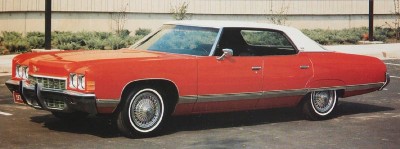
Chevrolet made the 1972 Chevrolet Caprice with two four-door body styles.
The wheelbase of the 1971 Chevrolet Impala grew by half an inch, as it did on Chevy's other full-size cars, and overall lengths reached 220 inches. Dimensions of that magnitude made Chevrolets the biggest of the "Big Three" makes. Station wagons stuck with their former 125-inch wheelbase but were stretched a bit to an immense 226 inches overall.
All-new front ends built around a vee-shaped grille gave the Biscayne, Bel Air, Impala, and prestigious Caprice a fresh and unique face, unrelated to other models. Said the Caprice sales brochure: "You'll like driving behind a stately grille that could be on cars priced hundreds of dollars more." Brookwood, Townsman, Kingswood, and Kingswood Estate wagons rounded out the full-size picture.
Full-size Chevrolet production (including station wagons) topped the million mark this season. Only 6,456 Impala convertibles were built, but the Impala series as a whole continued to sell strongly -- a true American favorite, and the most popular model nameplate in automotive history. In fact, the ten-millionth Impala was sold this year. Caprices were no slouches in the sales race, either, with 178,455 rolling out the factory door.
Engine choices reached as far as a 270-horsepower version of the 454-cubic-inch V-8. Also available: a 210-horsepower 402-cubic-inch V-8 and a 170-horsepower 400, along with 165- and 200-horsepower 350s. Fewer than 3,900 full-size Chevrolets had a six-cylinder engine.

The 1972 Chevrolet Caprice came as a pillared 4-door Sedan or a Hardtop Sedan.
Three luxurious Caprice models now were available, including a new pillared four-door sedan. Caprices had nothing less than a Turbo-Fire 400 V-8, with variable-ratio power steering and Turbo Hydra-Matic. Top-of-the-line wagon, as before, was the Kingswood Estate with simulated wood along the bodysides. Ventilation louvers disappeared from the tailgates of full-size station wagons.
Chevrolet's general manager, John Z. DeLorean, left GM this year to begin his ill-fated venture with the stainless-steel sports car that bore his own name.
1972 Chevrolet Biscayne, Bel Air, Impala, and Caprice Facts
| Model | Weight range (lbs.) | Price range (new) | Number built |
| Biscayne | 3,857-4,045 | $3,074-$3,408 | 20,538 |
| Bel Air | 3,854-4,042 | $3,204-$3,538 | 41,888 |
| Impala | 3,864-4,150 | $3,369-$3,979 | 597,541 |
| Caprice | 4,102-4,203 | $4,009-$4,076 | 178,455 |
| Station Wagon | 4,686-4,883 | $3,882-$4,423 | 171,703 |
1973 Chevrolet Bel Air, Impala, and Caprice
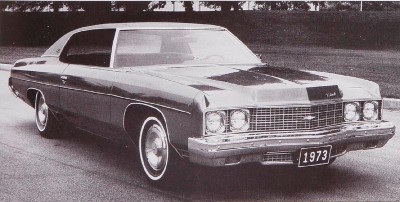
Front bumpers on the 1973 Chevrolet Impala and other full-size Chevys protruded because of the new federal mandate to withstand a 5-mph impact.
Apart from Corvettes, the 1973 Chevrolet Caprice Classic was the only convertible in the Chevy lineup that year; the bow-tie division built 7,339 of the $4,345 open-top model. Caprice was promoted in ads as "the uppermost Chevrolet." No more Biscaynes were built, making Bel Air the base model and Impala the mid-range, with Caprice presiding at the top of the pile.
Station wagons were absorbed into passenger-car lines, so the top-line wagon was called the Caprice Estate, and the Biscayne-based Brookwood disappeared. Except for wagons, all Caprice models came with standard rear fender skirts to accentuate the car's sweeping lines.
Five-mph front bumpers now were required, but rear bumpers needed only to meet a 21/2-mph standard, so those were less obtrusive. Roofs were strengthened, and side door beams thickened.
Modified front-end styling included two different grille styles, plus the new bumpers and fender caps. Caprice grilles had a looser crosshatch pattern. Taillights were more square in shape, set into moderately restyled back bumpers. Following the tradition established years earlier, Caprices had three taillights on each side, whereas lesser models made do with two. The Glide-Away tailgate continued as an exclusive feature on full-size wagons.
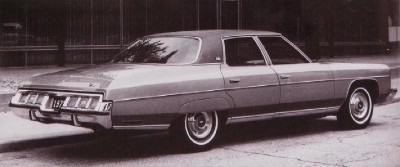
The 1973 Chevrolet Caprice Classic four-door Sedan found more than 58,000 buyers as the line gained popularity.
Base engine remained a 250-cubic-inch six or 307-cubic-inch V-8, but full-size models might have a 350 V-8. Caprices could even get a 454 (215 or 245 horsepower). Chevrolet's original "small-block" V-8 was enlarged to 400 cubic inches, breathing through a two-barrel carburetor to develop a rather meager 150 horsepower. Six-cylinder engines were installed only in Bel Airs with column-shifted three-speeds. All full-size cars with a 350-cubic-inch V-8 or greater ran Turbo Hydra-Matic.
Fuel tanks held 22 gallons of gasoline -- and owners had to make frequent trips to the gas station for fill-ups, as these biggies were far from frugal. That little engineering imperfection would loom large when the gas crisis arrived late in 1973, and frantic motorists had to sit in long lines to get at the pumps.
1973 Chevrolet Bel Air, Impala, and Caprice Facts
| Model | Weight range (lbs.) | Price range (new) | Number built |
| Bel Air | 3,895-4,087 | $3,247-$3,595 | 41,832 |
| Impala | 4,096-4,162 | $3,386-$3,822 | 549,482 |
| Caprice | 4,103-4,208 | $4,064-$4,345 | 212,754 |
| Station Wagon | 4,717-4,858 | $4,022-$4,496 | 173,978 |
1974 Chevrolet Bel Air, Impala, and Caprice
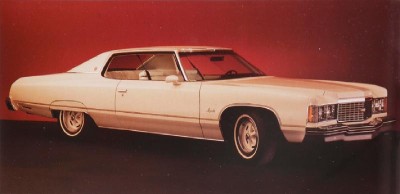
The 1974 Chevrolet Impala lost buyer appeal due to the energy crisis.
The 1974 Chevrolet Impala got some bad news: overall Chevrolet production skidded 15 percent this year, due in large measure to the energy crisis that resulted from the OPEC oil embargo of 1973-74. Practically overnight, it seemed, Americans said "no" to big cars like the Impala, Caprice and Bel Air, and turned to thriftier, smaller vehicles. Jacking up prices by 10 percent surely didn't help, either.
Dramatic new Custom Coupe rooflines continued the "Colonnade" styling that debuted on the previous year's Chevelles, with long fixed quarter windows -- larger in size this season -- instead of roll-down glass. True pillarless hardtop coupes remained, including the Impala Sport Coupe that continued the roofline introduced in 1973 -- rather reminiscent of the original '66 Caprice's roof treatment. A restyled grille had distinctive, bright-accented vertical bars. Caprice Classics could have a 50/50 reclining passenger seat.
Sales brochures promoted the Caprice Classic's "enviable luxury," aimed at "people who think driving is something the car should do." Oddly, the Caprice Classic four-door sedan was outsold by coupe and hardtop sedan counterparts, both of which cost more. Not many convertibles remained in the American market, but Chevrolet continued to offer the open Caprice Classic. Full-size cars rode a new radial-tuned suspension and steel-belted radial tires.
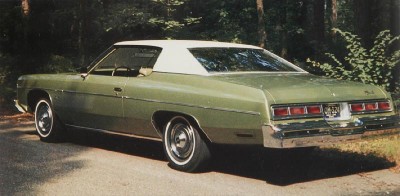
Despite energy issues, the 1974 Impala Sport Coupe sold more than 50,000 units.
A limited-edition "Spirit of America" series debuted in the Impala, Nova, and Vega lines, bearing a patriotic theme. Each car was painted white with red and blue accent striping and special identification. Impalas also got distinctive wheels.
Full-size wagons again had the Glide-Away tailgate. With the optional 454-cubic-inch V-8 and its 235 horsepower, a full-size station wagon could tow as much as 7,000 pounds. Station wagons had a standard 400-cubic-inch V-8, rated at 180 horsepower, whereas other full-size models started with a choice of 350-cubic-inch V-8s. Caprices got a 150-horsepower rendition of the 400-cubic-inch powerplant.
1974 Chevrolet Bel Air, Impala, and Caprice Facts
| Model | Weight range (lbs.) | Price range (new) | Number built |
| Bel Air | 4,148 | $3,960 | 24,778 |
| Impala | 4,167-4,256 | $4,135-$4,229 | 357,754 |
| Caprice | 4,245-4,344 | $4,465-$4,745 | 155,908 |
| Station Wagon | 4,829-5,004 | $4,464-$4,914 | 91,407 |
1975 Chevrolet Bel Air, Impala, and Caprice
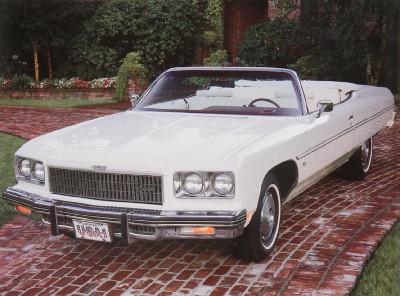
The 1975 Chevrolet Caprice Classic was the last full-size convertible for Chevy.
The 1975 Chevrolet Impala was sold on an advertising theme of "Chevrolet makes sense for America." And big cars like the Impala and Caprice -- despite their gas-hungry nature -- were heavily advertised.
Chevy's flagship, the Caprice Classic hardtop sedan, measured 223 inches from stem to stern. Side windows were cut into the roof's sail panels, giving the four-door hardtop a fresh appearance. Fender skirts were standard, along with bright wheel moldings. All Caprices were fully trimmed Classics, available in five body styles: coupe, Landau coupe, four-door sedan, sport sedan, and convertible.
This was the final year for the full-size Chevrolet convertible -- a Caprice, which listed for $5,113 but typically carried a lot of extra accessories. For the first time, convertibles could have a 50/50 reclining passenger seat and a sport cloth interior. Production of 8,349 full-size ragtops actually was higher than it had been since 1970, when 9,562 open Impalas went to dealerships. The age of the oversize, ostentatious American convertible was over.
Two coupes and two sedans, pillared and pillarless, made up the Impala line, still promoted as "America's favorite car." A Landau coupe also was available but sold sparsely. Only 2,465 were produced.
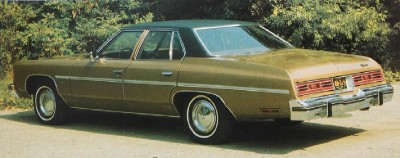
The 1975 Chevrolet Impala four-door Sedan was the best-selling full-size Chevy that year.
Wearing its new roofline with larger rear door windows, pillared Impala sedans sold well, with 91,330 built. Facing its final season, the Bel Air line included nothing other than a four-door sedan, which had a lot more trouble finding customers. Total sales of full-size models continued their downward slide, reaching about half their 1973 total.
All Chevrolet passenger cars got a "GM Efficiency System" that included a catalytic converter and electronic High Energy Ignition system. Installation of the "cat" permitted engine recalibrations which, in many cases, brought improved gas mileage and durability. The full-size selection included three station wagons: Caprice Estate, Impala, and Bel Air, each with either two or three seats.
1975 Chevrolet Bel Air, Impala, and Caprice Facts
| Model | Weight range (lbs.) | Price range (new) | Number built |
| Bel Air | 4,179 | $4,345 | 15,871 |
| Impala | 4,190-4,265 | $4,548-$4,901 | 211,708 |
| Caprice | 4,275-4,360 | $4,819-$5,113 | 122,339 |
| Station Wagon | 4,856-5,036 | $4,878-$5,351 | 71,766 |
1976 Chevrolet Impala and Caprice
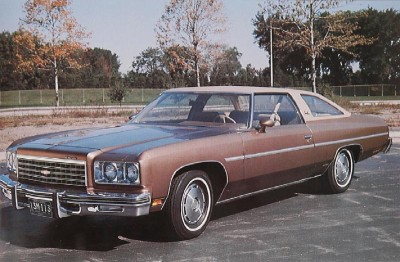
Front-end styling on the 1976 Chevrolet Impala Custom Coupe carried on the Caprice look of a year before.
The 1976 Chevrolet Impala and Caprice were the only full-size Chevys this year (Bel Airs were gone), and they shared new front-end styling that included a reworked grille. Caprices displayed new rectangular headlights and triple-unit wraparound taillights, while Impalas used four round headlights. The pillarless Impala Sport Coupe faded out of the lineup, so a formal-profiled Custom Coupe was the only Impala two-door. After 1976, the four-door hardtop body style also would disappear.
Measuring more than 222 inches overall on a 121.5-inch wheelbase, the Caprice Classic and Impala ranked as the last of the really big Chevys. For the last time, a 454-cubic-inch V-8 engine could be installed in Chevrolets, now yielding 225 horsepower. Full-size cars made the most of their perimeter frame and full coil-spring suspension to deliver a smooth ride that pleased their owners.
Both models had such luxuries as simulated rosewood vinyl trim on the instrument panel, steering wheel, and doors. Each rode steel-belted radial tires and carried an automatic transmission, power brakes, and variable-ratio power steering. The standard bench seat could be replaced by a 50/50 split front seat. Landau Coupes had a harmonizing padded elk-grain vinyl half-roof.

The 1976 Chevrolet Impala 4-door Sedan sold more than 86,000 copies.
"There's no such thing as too much comfort," said the sales brochure of Chevrolet's Caprice Classic, offered as a sedan, sport sedan, coupe, and Landau coupe. Interiors contained new standard knit cloth/vinyl upholstery or soft expanded all-vinyl. Front and rear stabilizer bars were standard, along with a radial-tuned suspension system with modified shock absorbers.
Impalas came in the same four body styles as the Caprice, billed as "a tradition that keeps getting better." Low-budget buyers could get an Impala S four-door sedan, lacking extra trim and steel-belted tires. Options included a reclining passenger seat, power six-way front seat, power locks and windows, power trunk opener, rear defogger, and Four-Season or Comfortron air conditioning.
1976 Chevrolet Impala and Caprice Facts
| Model | Weight range (lbs.) | Price range (new) | Number built |
| Impala | 4,175-4,245 | $4,507-$5,058 | 198,231 |
| Caprice | 4,244-4,314 | $5,013-$5,284 | 152,806 |
| Station Wagon | 4,912-5,007 | $5,166-$5,546 | 72,819 |
1977 Chevrolet Impala and Caprice
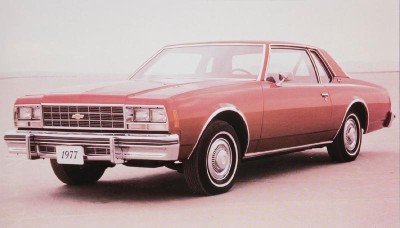
The 1977 Chevrolet Impala downsized the model but increased interior space.
The 1977 Chevrolet Impala and Caprice, like other GM models, got a dramatic downsizing for 1977 as part of a total B-body redesign. Shorter, taller, and narrower, billed as "The New Chevrolet," the new full-size cars promised to be "more appropriate for the times," more manageable, and occupying "a little less space in the world."
Of course, customers were assured that the reduced-size models actually offered more interior space, not less. In fact, head room and rear leg room were greater than in '76 models. So was trunk space, measuring 20.2 cubic feet in the sedan.
Chevrolet pulled out all the stops to launch its freshly shrunken line. Motor Trend honored the downsized Chevrolet, naming it Car of the Year. In this new, sleeker form, the biggest Chevrolets would continue -- with a minor facelift in 1980 -- all the way through the 1990 model year. Downsized full-size models would see massive service in police fleets through the late 1970s and '80s (and beyond), a tribute to the car's engineering excellence -- and the performance of the small-block V-8 in particular.
Six-cylinder engines were back as part of the efficiency focus. EPA mileage ratings reached 22-mpg highway and 17 city with six-cylinder power, and 20 highway/16 city with the new 305-cubic-inch V-8. The latter was the most popular, producing 145 horsepower with a two-barrel carburetor, though a 170-horsepower 350-cubic-inch V-8 was also available. In other news, a new Smart Switch operated the dimmer and turn signals.
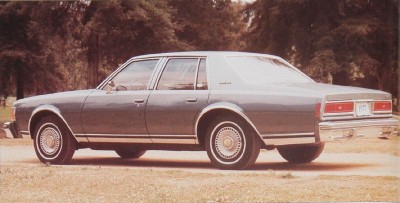
The 1977 Chevrolet Caprice Classic was smaller and more efficient than before.
Station wagons lost their Glide-Away tailgates, replaced by an ordinary Door-Gate that opened sideways or folded down. Wagon wheelbases shrunk from 125 to 116 inches, the same as coupes and sedans, and overall length trimmed down by more than a foot.
The Impala series consisted of a coupe, four-door sedan, and four-door station wagon (with two or three seats). At midyear, a lavishly trimmed Impala Landau Coupe joined the line. The completely different Caprice redefined the entire concept of the American-made full-size automobile, signaling "the shape of cars to come."
1977 Chevrolet Impala and Caprice Facts
| Model | Weight range (lbs.) | Price range (new) | Number built |
| Impala | 3,533-4,072 | $4,876-$5,406 | 320,279 |
| Caprice | 3,571-4,118 | $5,187-$5,734 | 341,382 |
1978 Chevrolet Impala and Caprice

Chevrolet changed the 1978 Chevrolet Caprice Classic's grille and taillights.
The 1978 Chevrolet Impala and Caprice, in their second model year, were "trim, crisp, beautiful," according to the company line. Of course, this came after Chevrolet proclaimed that its downsized '77s had become "the most successful new car in the country."
Caprice Classics had a distinctive new grille and stand-up hood crest, and their own wheel covers. Taillights were modestly restyled, and a Power Skyroof became available. Caprices also had carpeted lower door panels, simulated woodgrain accents, and extra sound insulation. Impalas got a fresh grille and redesigned taillights with bigger backup lights.
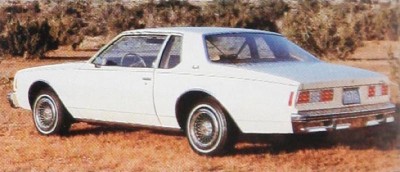
The 1978 Chevrolet Impala line included a Coupe model.
More than 609,000 full-size Chevrolets headed toward dealerships, with Impala and Caprice four-door sedans the most popular models. Big coupes drew far fewer sales, and Landau variants even less. Only 33,990 Impala coupes and 4652 Landau coupes were produced. Most coupe buyers preferred the posher Caprice Classic. Interiors came in cloth or vinyl, but one option included a 50/50 split front seat.
Impalas and Caprices still came standard with a 110-horsepower six, but two V-8s were available: 305- or 350-cubic-inch, developing 145 or 170 horses, respectively. As with most cars in the late '70s, California engine ratings were lower than those sold elsewhere. All full-size cars had automatic transmissions.
1978 Chevrolet Impala and Caprice Facts
| Model | Weight range (lbs.) | Price range (new) | Number built |
| Impala | 3,511-4,071 | $5,208-$5,904 | 290,744 |
| Caprice | 3,548-4,109 | $5,526-$6,151 | 321,653 |
1979 Chevrolet Impala and Caprice
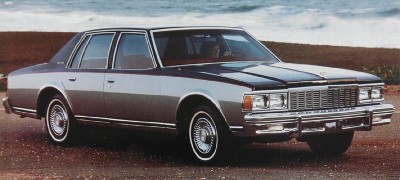
The 1979 Chevrolet Caprice Classic's most noticeable change was a subtly reworked grille and headlights.
The 1979 Chevrolet Impala and Caprice were a "standard of success by which other full-size cars should be judged," according to Chevrolet.
Then again, this is the company whose ads in 1979 promoted fuel efficiency even for the Caprice, still billed as "The New Chevrolet." That designation had been given to downsized full-size models in 1977, but changes were modest this year. Caprice Classics got a new segmented grille with bold vertical accents and a revised headlight design. Coupes and sedans also adopted a refinement of the traditional triple-segment taillights.
"America has driven it to the top," the sales brochure crowed, as this "new generation" had "become the most popular of our times."
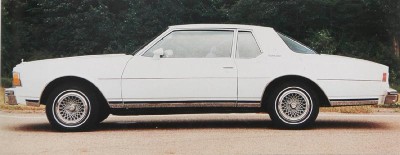
The 1979 Chevrolet Caprice Classic came standard with bodyside pinstriping.
Engine choices again began with a 250-cubic-inch six and 305-cubic-inch V-8, with a 170-horsepower 350-cubic-inch V-8 optional. Options included a Power Skyroof, six-way power seat, intermittent wipers, Comfortron automatic air conditioning, electric rear defogger, power antenna, and power trunk opener. A separate brochure described Chevrolet police vehicles: Malibus and Impalas, with departing Novas omitted.
Output of full-size cars dipped just a little, to 588,638 units. Even so, that total stood beyond any other series, though Malibu wasn't so far behind. For millions of Americans, the name Chevrolet and big cars, even the downsized biggies, were nearly synonymous.
1979 Chevrolet Impala and Caprice Facts
| Model | Weight range (lbs.) | Price range (new) | Number built |
| Impala | 3,495-4,045 | $5,828-$6,947 | 270,907 |
| Caprice | 3,538-4,088 | $6,198-$6,960 | 317,731 |
1980 Chevrolet Impala and Caprice Classic
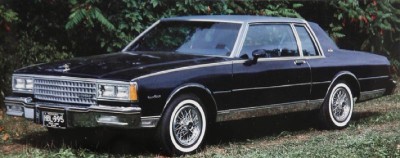
The 1980 Chevrolet Caprice Classic and Impala were best served by the optional 305-cubic-inch V-8.
The 1980 Chevrolet Impala and Caprice received their first facelift since being completely redesigned and "downsized" for 1977. Differences, however, were subtle: The hood and front fenders were lowered slightly and given a more rounded contour, while the coupe's wraparound rear window gave way to a flat rear window fixed to more upright roof pillars.
Buyers were offered a choice of V-6 or V-8 engines. Replacing the old 250-cubic-inch inline six as the base powerplant was a new 229-cubic-inch V-6 rated at the same 115 horsepower, though California buyers got a Buick-built 231-cubic-inch V-6 with 110. V-8 options included a 267-cubic-inch unit packing 120 horsepower and a 155-horse 305.
Wagons came standard with the smaller V-8, while the 305 and a 105-horsepower Oldsmobile 350 diesel V-8 were optional. The standard, and only, transmission was a three-speed automatic.
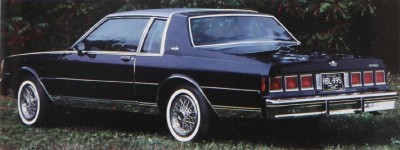
Chevrolet ditched the wraparound rear window for the 1980 Caprice Classic.
Full-size Chevys continued their two-tier lineup. Impala carried on as the base-trim model, while Caprice Classic designated the ritzy variant. Four-doors far outsold two-doors and wagons, and Caprices generally outsold Impalas.
The fuel crisis of '79 put a dent in all big-car sales, and the Impala and Caprice were no exception. Furthermore, the new Citation may have skimmed off some more potential buyers, and the result was a dismal year for the big Chevys: From over half-a-million sales in 1979, volume dropped to less than half that number in 1980. The Impala and Caprice would never regain their former popularity.
1980 Chevrolet Impala and Caprice Classic Facts
| Model | Weight range (lbs.) | Price range (new) | Number built |
| Impala | 3,344-3,924 | $6,535-$7,186 | 99,527 |
| Caprice | 3,376-3,962 | $6,946-$7,536 | 137,288 |
| Sport Coupe | 3,104-3,219 | 6,524-6,604 | 116,580 |
| Landau Coupe | not available | 6,772-6,852 | 32,262 |
1981 Chevrolet Impala and Caprice Classic

The 1981 Chevrolet Impala tweaked its transmission to improve mileage.
Changes for the 1981 Chevrolet Impala and Caprice Classic were almost dramatic compared to the subtle year-to-year changes normally seen on Chevrolet's full-size line. Visually, the cars changed little, but underneath were some commendable improvements.
GM's Computer Command Control (CCC) emission system improved driveability somewhat while lending a hand in meeting 1981's stricter emissions regulations, but bigger news came in the form of a new four-speed automatic transmission with long-legged 0.67:1 overdrive fourth gear. Combined with a lock-up torque converter, a Caprice or Impala with the 305-cubic-inch V-8 (the only engine available with the four-speed automatic) registered an impressive 26 EPA highway miles-per-gallon, a figure that could very nearly be duplicated in "real world" driving.

The handsome 1981 Chevrolet Impala stayed competitive even as a full-size.
Engine choices continued from 1980 but with slightly less horsepower. The base powerplant was again a 229-cubic-inch V-6, now with 110 horsepower (California cars got a Buick-built 231, also with 110 horsepower). Optional was a 267-cubic-inch V-8 with 115 horsepower and the aforementioned 305 V-8 with 150.
For 1980, only station wagons could get an Oldsmobile 350-cubic-inch diesel V-8, but availability of that engine was expanded to include all Impala and Caprice models for 1981.
1981 Chevrolet Impala and Caprice Classic Facts
| Model | Weight range (lbs.) | Price range (new) | Number built |
| Impala | 3,326-3,897 | $7,129-$7,765 | 85,964 |
| Caprice | 3,363-3,940 | $7,534-$8,112 | 133,461 |
1982 Chevrolet Impala and Caprice Classic
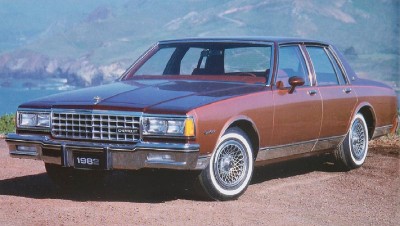
Chevrolet successfully promoted the comfort and low prices of its 1982 Chevrolet Caprice Classic and Impala.
Because the 1982 Chevrolet Impala and Caprice Classic were initially rumored to be in their last year, the pair understandably received few changes. Offerings were trimmed, however: The slow-selling Impala sport coupe and Caprice Landau sport coupe didn't make the cut, leaving the Caprice sport coupe as the only two-door offering.

The 1982 Chevrolet Impala offered a smooth ride and plenty of room.
Powertrains remained the same, except that the four-speed automatic introduced the previous year for the 5.0-liter (305-cubic-inch) V-8 was now available on the smaller 4.4-liter (267-cubic-inch) V-8 as well. Chevy's 3.8-liter 229-cubic-inch V-6 remained standard on coupes and sedans, while wagons again came with the smaller V-8 (except in California, where coupes and sedans got Buick's 231-cubic-inch V-6, and the standard engine for wagons was the 305-cubic-inch V-8). As before, the Olds-built 350 diesel V-8 was optional across the board.
Though big, old-fashioned cars like the Impala and Caprice lost much of their appeal in the wake of high fuel costs, the pair represented great value. With base prices of $7,918 for a roomy Impala sedan and just $8,367 for the ritzier (and far more popular) Caprice Classic sedan, these big family cruisers looked downright cheap next to $8,100 Cavalier CL subcompacts and $8,600 Celebrity intermediates.
1982 Chevrolet Impala and Caprice Classic Facts
| Model | Weight range (lbs.) | Price range (new) | Number built |
| Impala | 3,361-4,050 | $7,918-$8,670 | 64,679 |
| Caprice | 3,373-4,010 | $8,221-$9,051 | 123,510 |
1983 Chevrolet Impala and Caprice Classic
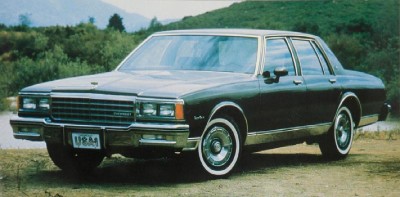
Despite rumors of its death, the 1983 Chevrolet Caprice Classic and similar Impala were the best-selling Chevys.
The 1983 Chevrolet Impala and Caprice Classic was rumored to be facing extinction, but the model persisted, albeit with a trimmed model lineup. Gone was the Caprice coupe, the last two-door version, and the Impala wagon.
Gone, too, was the smaller 4.4-liter V-8, which was never very popular, even during the gas-crisis days. That left the 3.8-liter 110-horsepower Chevy V-6 as the base powerplant (though Californians once again got a similar Buick-built engine), with options being the 150-horsepower 5.0-liter gas V-8 (standard on wagons) and 105-horsepower 5.7-liter diesel V-8. With all engines, a three-speed automatic transmission was standard, a four-speed automatic optional.
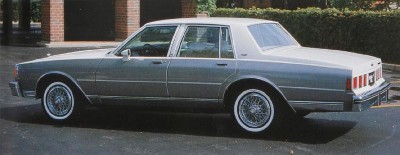
The sedan-only offering of the 1983 Chevrolet Caprice Classic and Impala suggested that Chevy was targeting an older audience.
Since these were lean years for Chevrolet, and GM in general, it was probably difficult to justify a replacement for the aging full-size cars. But with gas prices stabilizing and buyers once again leaning toward larger vehicles and V-8 engines, it was hard for Chevy to dismiss sales that continued to hover near 200,000 units annually.
And the Impala and Caprice -- despite the loss of their coupes -- were not only selling better than the year before, they were selling better than any other Chevrolet.
1983 Chevrolet Impala and Caprice Classic Facts
| Model | Weight range (lbs.) | Price range (new) | Number built |
| Impala | 3,490-3,594 | $8,331-$8,556 | 45,154 |
| Caprice | 3,537-4,092 | $8,802-$9,518 | 175,641 |
1984 Chevrolet Impala and Caprice Classic

The Chevrolet Caprice Classic was the only full-size, two-door Chevy in 1984.
While the Chevrolet Impala and Chevrolet Caprice Classic sedans continued to anchor Chevy's full-size lineup, the Chevrolet Caprice Classic coupe returned to the ranks for 1984. The Caprice Classic coupe had been dropped at the end of the 1982 model year. The 1984 Caprice Classic coupe, was the sole two-door vehicle offered in the full-size Caprice/Impala line and garnered nearly 20,000 orders for the year.
Other changes to Chevy's big rear-drive cars were fairly minor. Windshield wiper controls were moved from the dash to a more convenient location on the turn-signal stalk, while the optional cruise control now allowed incremental speed changes of one mph at a time.

A full-size Chevy wagon was also available only as a Caprice Classic in 1984.
Powertrains remained much the same as before, with a Chevy-built 110-horsepower 3.8-liter V-6 standard in coupes and sedans (a similar Buick V-6 again went into California cars). Standard in wagons and optional elsewhere was the good ol' 5.0-liter V-8, still with 150 horsepower, and optional on all was the 105-horsepower 5.7-liter diesel V-8. A three-speed automatic was standard on all but the 5.0-liter V-8, which got a four-speed automatic that was optional with the diesel.
With prices starting at under $9,000, the Impala and Caprice represented quite a bargain in 1984 dollars. Over 276,000 buyers agreed, prompting a 25-percent increase in sales over 1983.
1984 Chevrolet Impala and Caprice Classic Facts
| Model | Weight range (lbs.) | Price range (new) | Number built |
| Impala | 3,489-3,628 | $8,895-$9,270 | 55,296 |
| Caprice | 3,532-4,053 | $9,253-$10,210 | 221,199 |
1985 Chevrolet Impala and Caprice Classic
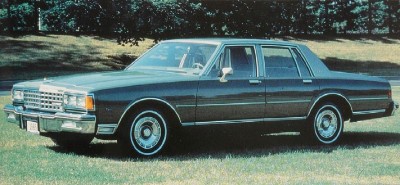
An emphatic grille announced the 1985 Chevrolet Caprice Classic.
The 1985 Chevrolet Impala and Caprice Classic received a number of refinements under the skin, although little changed visually. Inside, there were new instrument panel graphics, and underneath, the suspension was firmed up in order to reduce the "floating" that plagued earlier models that lacked the optional F41 suspension package.
Bigger news appeared on the engine charts. The previous 3.8-liter Chevy and Buick V-6s were replaced by a new 4.3-liter V-6, which was based on Chevy's legendary small-block V-8, with two cylinders chopped off. Fitted with throttle-body fuel injection, it produced 130 horsepower, 20 more than the old 3.8s.

1985 Chevrolet Caprice Classic station wagons upgraded to fit eight passengers.
The optional 5.0-liter V-8 received a compression boost that helped it find 15 more horses, now totaling 165. Returning unchanged was the 5.7-liter diesel V-8 with 105 horsepower. The V-6 and diesel V-8 came standard with a three-speed automatic transmission, with a four-speed automatic optional; the 5.0-liter V-8 came standard with the four-speed.
With a lineup that again included an Impala sedan and Caprice coupe, sedan, and wagon, the full-size Chevys continued to be as popular as ever, with sales nearing 265,000 units.
1985 Chevrolet Impala and Caprice Classic Facts
| Model | Weight range (lbs.) | Price range (new) | Number built |
| Impala | 3,508-3,634 | $9,519-$9,759 | 55,438 |
| Caprice | 3,525-4,083 | $9,888-$10,714 | 211,355 |
1994 Chevrolet Caprice and Impala SS
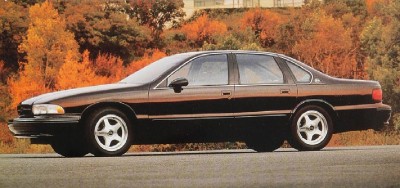
The 1994 Chevolet Impala SS was a variant of the Caprice.
The 1994 Chevrolet Impala SS was based on a 1992 show car and set enthusiast's hearts afire when it burst on the scene midway through the 1994 model year. Reviving a name from Chevy's performance roots, the Caprice-based Impala SS was little more than a styling exercise, but its success would spawn a series of similarly adorned concept cars from Chevy's rather bland stable of front-drive people-movers.
Coming just in time to give the Impala SS some bite to back up its bark was a heavily revised 5.7-liter V-8 carrying the honored LT1 label. Running on lower compression that allowed it to get by on regular gas, it produced 260 horsepower in this application, versus 275 in the Camaro Z28 and 300 in the Corvette -- both of which required premium. Nevertheless, it represented an 80-horsepower increase over the previous 5.7-liter V-8 offered in Chevy's full-size line.
Also new was a 4.3-liter V-8 producing 200 horsepower, which was the standard engine in Caprice sedans and wagons. While the Impala SS came standard with the 5.7-liter LT1, that engine was also optional on Caprices. Regardless of engine, the only transmission offered was a four-speed automatic.

Unfortunately, the 1994 Chevrolet Impala SS offered no manual transmission, and to makes matters worse the gear shifter was on the steering column.
What made the Impala SS special were its monochromatic paint scheme, available in black only; unique "dogleg" C-pillar inserts; "retro" Impala insignias; rear spoiler; and especially its wide 17-inch five-spoke aluminum wheels. A lowered sports suspension with De Carbon gas-pressurized shocks gave it better road manners than any previous full-size Chevy could hope to attain, and the potent powertrain drove through a standard limited-slip differential backed by four-wheel disc brakes. Inside, bucket seats and black dashboard trim signaled its sporting intent, but enthusiasts bemoaned the column-mounted shifter and lack of a tachometer.
Other news regarding Chevy's full-size line for 1994 paled by comparison, but there were some significant changes. The addition of a passenger-side air bag prompted a redesigned dash with digital speedometer and analog auxiliary gauges housed in one rectangular pod, and radio/climate controls in another. Also, the standard air conditioning now used CFC-free refrigerant.
1994 Chevrolet Impala SS and Caprice Facts
| Model | Weight range (lbs.) | Price range (new) | Number built |
| Impala SS | 4,218 | $22,495 | not available |
| Caprice | 4,036-4,541 | $18,995-$21,435 | 104,724 (includes Impala) |
1995 Chevrolet Impala SS

The Chevrolet Impala SS came back on 17-inch aluminum wheels in 1995.
The 1995 Chevrolet Impala SS, with the nameplate's mid-1994 debut sparking rave reviews from the automotive press, returned with only minor changes. Most noticeable was a wider palette of hues that expanded the original "any color so long as it's black" philosophy to include Dark Cherry and Green-Gray.
Interiors remained available in gray leather only. Like its Caprice counterpart, optional premium cassette and CD players featured speed-compensated volume control that adjusted radio volume to ambient noise levels.

Gray was the only interior color offered on the 1995 Chevrolet Impala SS.
The only powertrain offered was again the 260-horsepower 5.7-liter LT1 V-8 mated to a four-speed automatic transmission. Since this same combination was optional on the Caprice, the Impala SS remained largely an appearance upgrade -- and even that was compromised somewhat this year, as the Caprice took on the Impala's "dog leg" rear roof pillar.
However, the Impala featured a more sophisticated suspension system that gave it amazing agility for a two-ton sedan. It also retained its unique monochromatic paint treatment, aero body aids, and those beautiful 17-inch aluminum wheels.
1995 Chevrolet Impala SS Facts
| Model | Weight range (lbs.) | Price range (new) | Number built |
| Impala SS | 4,036 | $22,910 | not available |
1996 Chevrolet Impala SS

The 1996 Chevrolet Impala SS was perhaps the most novel Chevrolet of the 1990s.
The 1996 Chevrolet Impala SS was in its best year, and it was a shame that 1996 would also be Impala's last. Doomed to extinction by the demise of the Caprice on which it was based, the highly touted Impala SS saw a number of significant refinements that improved what was already an exceptional car -- just as the axe began to fall.
In retrospect, it was surprising that the Impala received any changes at all. There had long been rumors that the Arlington plant would switch over to building pickups, so it couldn't have came as a shock to anyone on the Impala team. The Caprice returned in virtually carbon-copy form, and Chevrolet could probably have sold as many Impalas as it could build even if it, too, were a carryover.
But whatever the reason, Chevy engineers fixed almost every complaint leveled against the original concept, most aimed at the interior. It wasn't sporting, after all, to shift gears with a column-mounted lever, and what performance car could possibly be called complete without a tachometer?

After the 1996 year, the Impala name would ride off into the sunset.
In answer to the first objection, Impala was given a floor-mounted shifter housed in a proper console -- bearing an Impala logo no less. Then the instrument panel was completely redesigned, adding not only an analog tach, but also an analog speedometer to replace the former digital unit. Both revisions served to not only further distinguish the Impala from a garden-variety Caprice, but also to make it fit the mold of a true sport sedan.
Chevy anticipated building only about 15,000 Impala SS sedans for 1996. In most enthusiast's minds, it wouldn't be nearly enough.
1996 Chevrolet Impala SS Facts
| Model | Weight range (lbs.) | Price range (new) | Number built |
| Impala SS | 4,036 | $24,405 | not available |
How To Draw A Chevy Impala
Source: https://auto.howstuffworks.com/chevrolet-impala.htm
Posted by: yeltonthationothe.blogspot.com

0 Response to "How To Draw A Chevy Impala"
Post a Comment